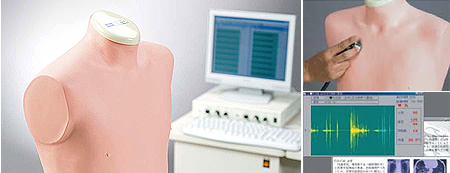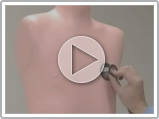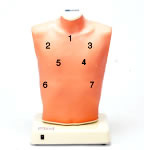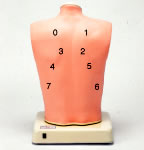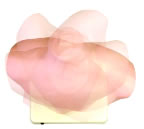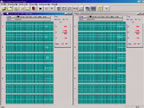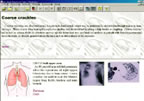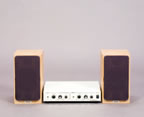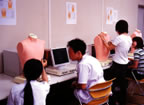M-81-S
Features
Outstanding sound qualityCases are recorded from actual patients; sounds are exactly those of real patients. Computer synchronization of all outputs.Accurate location and spread of lung sounds15 speakers are located in the torso manikin (seven in the anterior, eight in the posterior), each speaker playing back sounds distinct to each auscultation area. Speakers are completely synchronized. The torso rotates on a base, allowing examination of both the front and back as in a real clinical procedure.Efficient selection of the casesCases are carefully selected for educational purposes based on classification standards of the American Thoracic Society.Useful explanation windows-including illustrations, chest radiographs and CT images-enhance training |
|
Anterior area
|
|
Posterior area
|
|
|
The torso model rotates on a base allowing examination of both the front and back of the chest as in actual clinical procedures. |
|
|
Sounds can be monitored graphically in real time. The sound volume, the pace of respiration and the operating time are adjustable, expanding the variety of training options. |
|
|
Actual stethoscopes can be used for training.
|
|
|
Explanation window for each case can be referred on the monitor. General descriptions along with clinical data on individual cases including patient histories, illustrations, radiographs and CT images. |
|
|
External speaker system facilitates demonstrations and group study. |
|
|
LSAT can be applied to evaluating clinical skills objectively. |
|
|
|
|
Teknisk informasjon
The classification of lung sounds is based on the criteria of the American Thoracic Society.
| 36 cases are available for training. 34 cases include 2 versions -- with and without heart-sounds | |||
|---|---|---|---|
| NORMAL | standard | FINE CRACKES | both lower area |
| mildly weak | both lower and middle area | ||
| mildly strong | whole thorax 1 | ||
| mildly rapid | whole thorax 2 | ||
| loud heart sounds | WHEEZES | upper and middle area | |
| ABNORMAL | weak: left lower area | around trachea and upper area1 | |
| weak: left whole area | around trachea and upper area2 (polyphone) | ||
| absent: left | RHONCHI | trachea and upper area | |
| weak: right lower area | trachea and upper area (polyphonic) | ||
| weak: right lower area | with an inspiratory wheeze | ||
| absent right | whole thorax | ||
| weak: whole thorax | MISCELLANEOUS CONTINUOUS SOUND |
stridor | |
| bronchial sounds | squawk | ||
| COARSE CRACKELS | right lower area | MISCELLANEOUS | pleural friction rub: left lower area |
| both lower area | pleural friction rub: right lower and middle area | ||
| right middle area | Hamman's sign | ||
| left lower area | Vocal fremitus (palpable at both sides of the chest) | ||
| both upper area | |||
| whole thorax | |||
Components & Specifications
| Component | Qty | Measurements | Packing size | Specifications |
|---|---|---|---|---|
| LSAT model unit | 1 | 32 x 35 x 62H cm | 51 x 46 x 80 cm 10 kg | Torso with rotary base 15 built-in speakers 8 ch. amplifier |
| PC | 1 | 59 x 59 x 40 cm 15 kg | Windows XP, 12ch.D/A PCI board,mouse, 112keyboard, 15"TFT monitor *Software & data installed |
|
| Amplifier | 1 | 32 x 35 x 8H cm | 46 x 46 x 15 cm 10 kg | AC 120-240V |
| Speakers | 2 | 62 x 41 x 40 cm 20 kg (incl. monitor) |
||
| T-shirt | 1 | free size |
